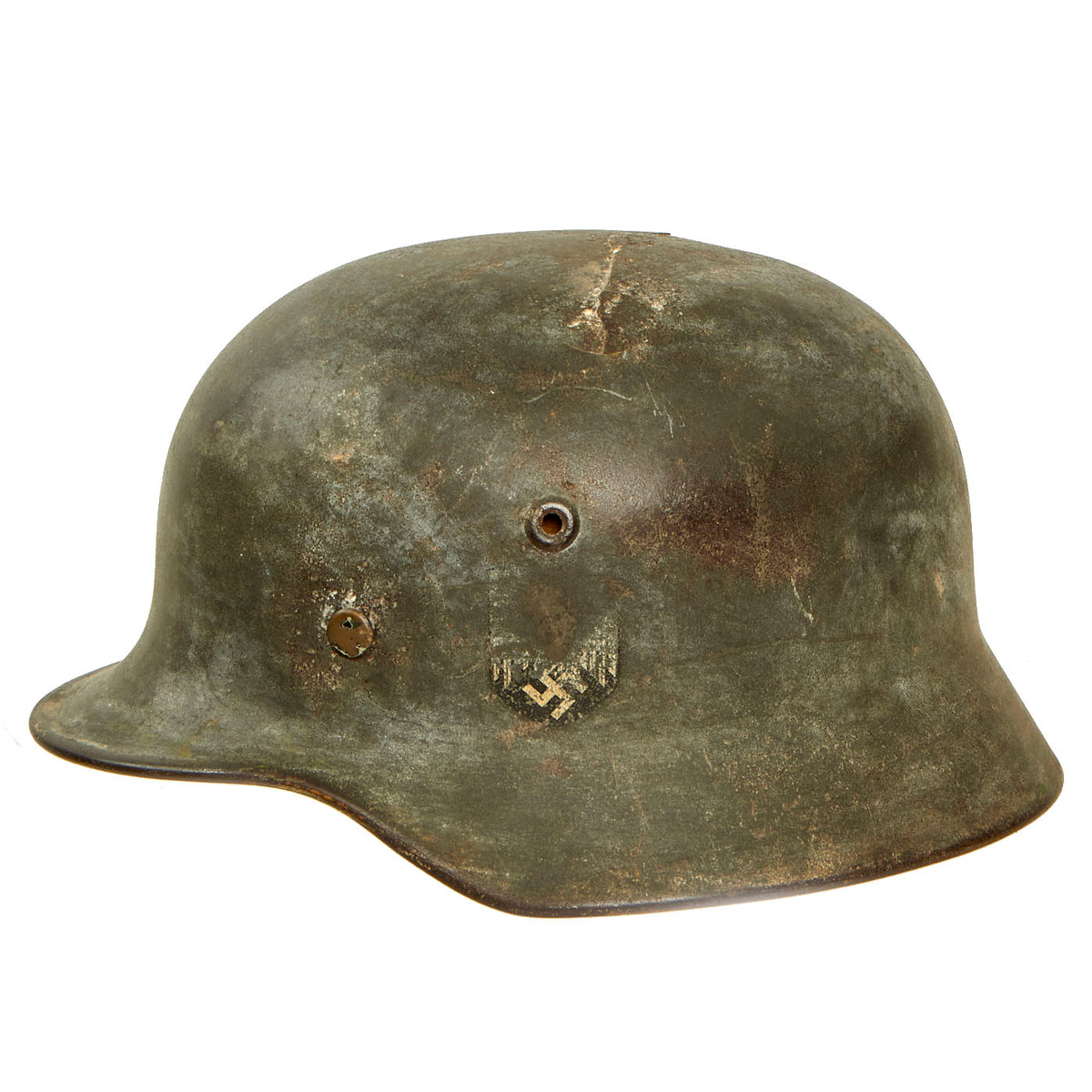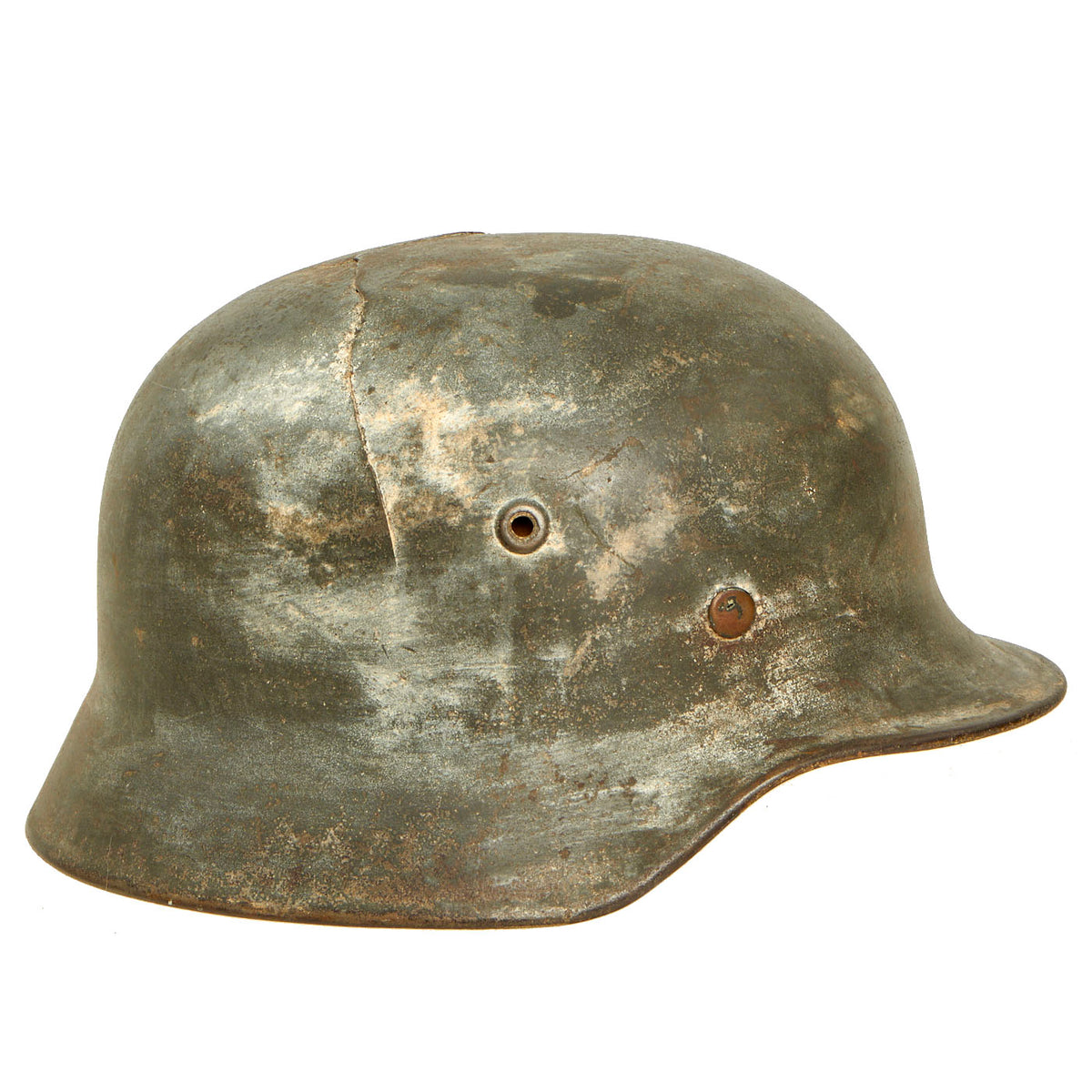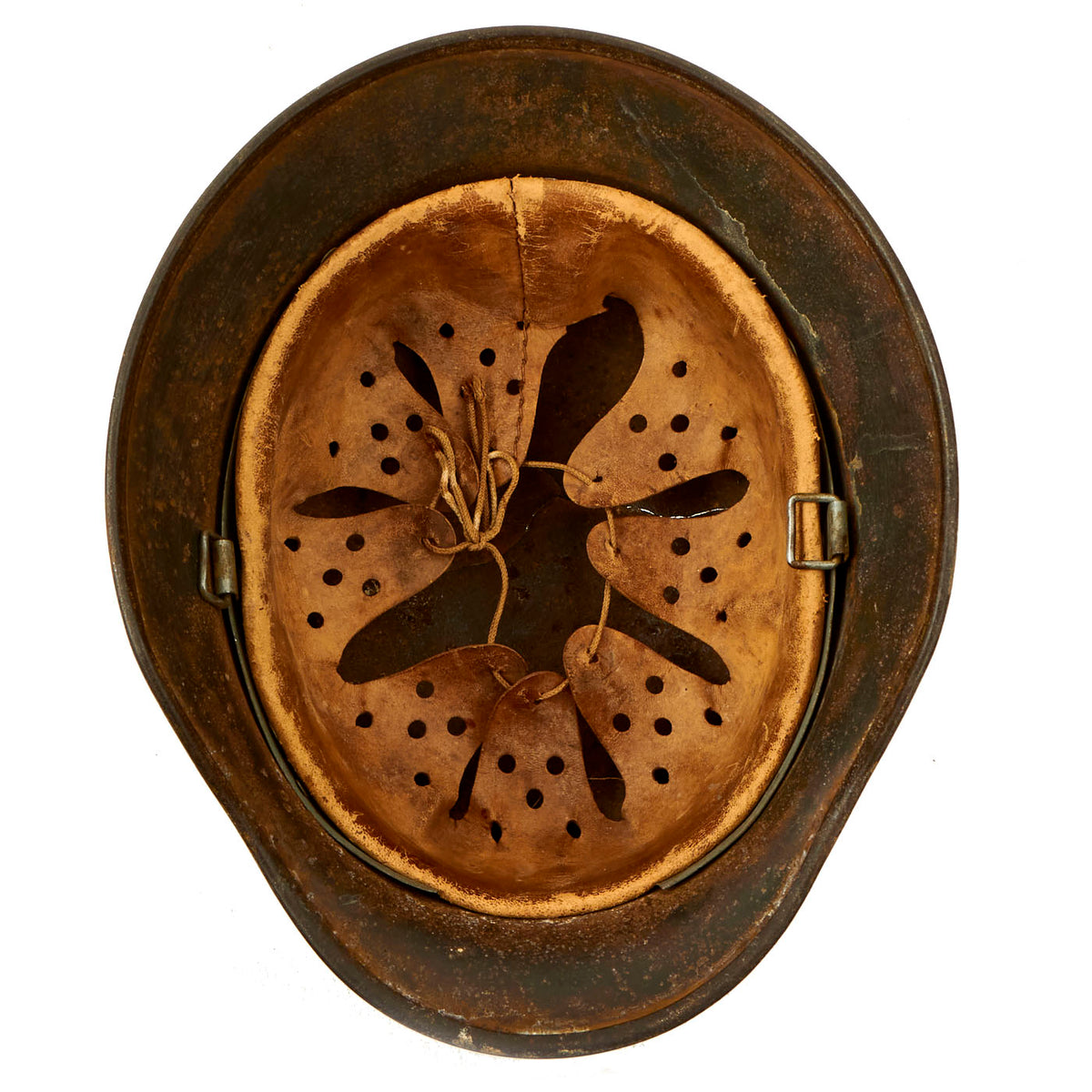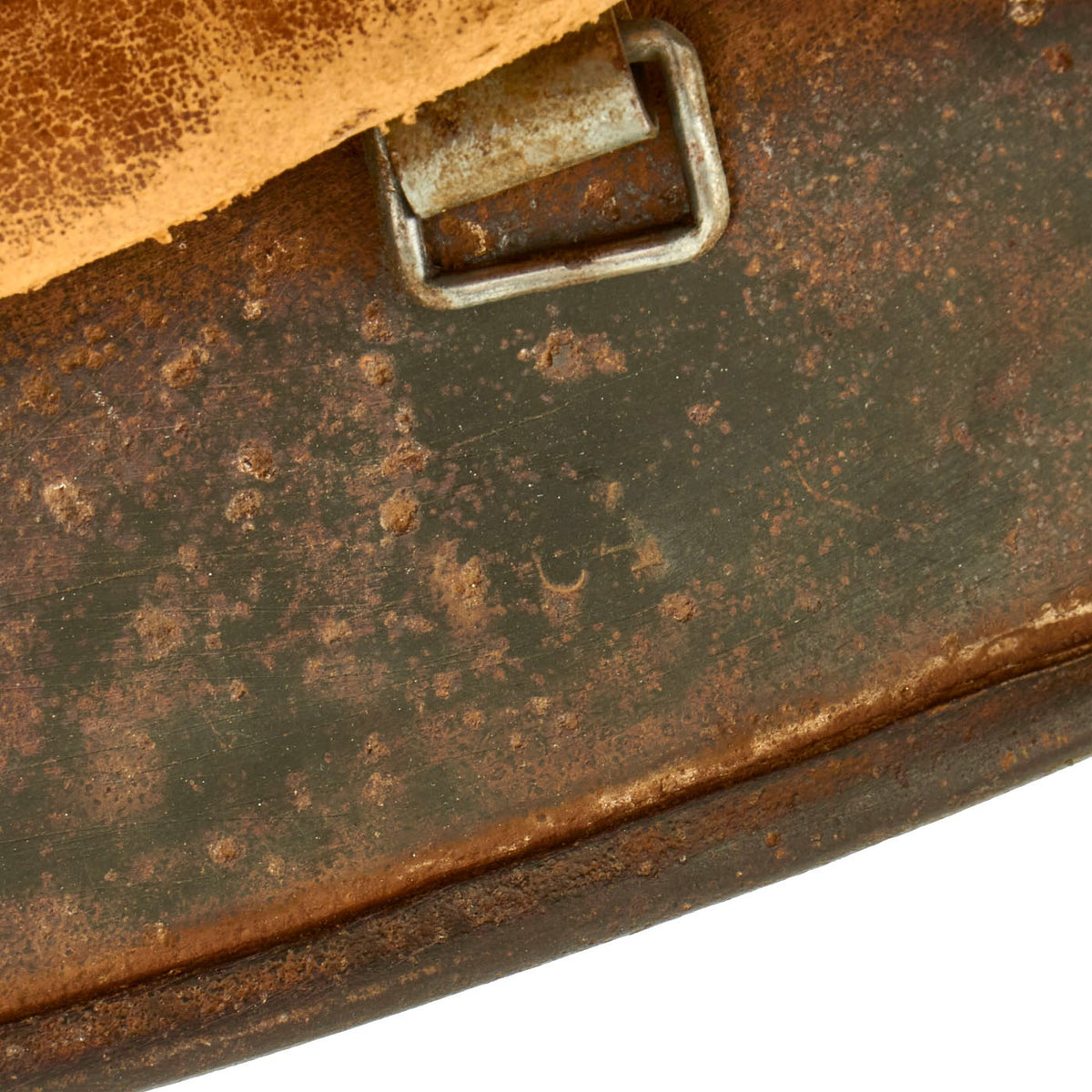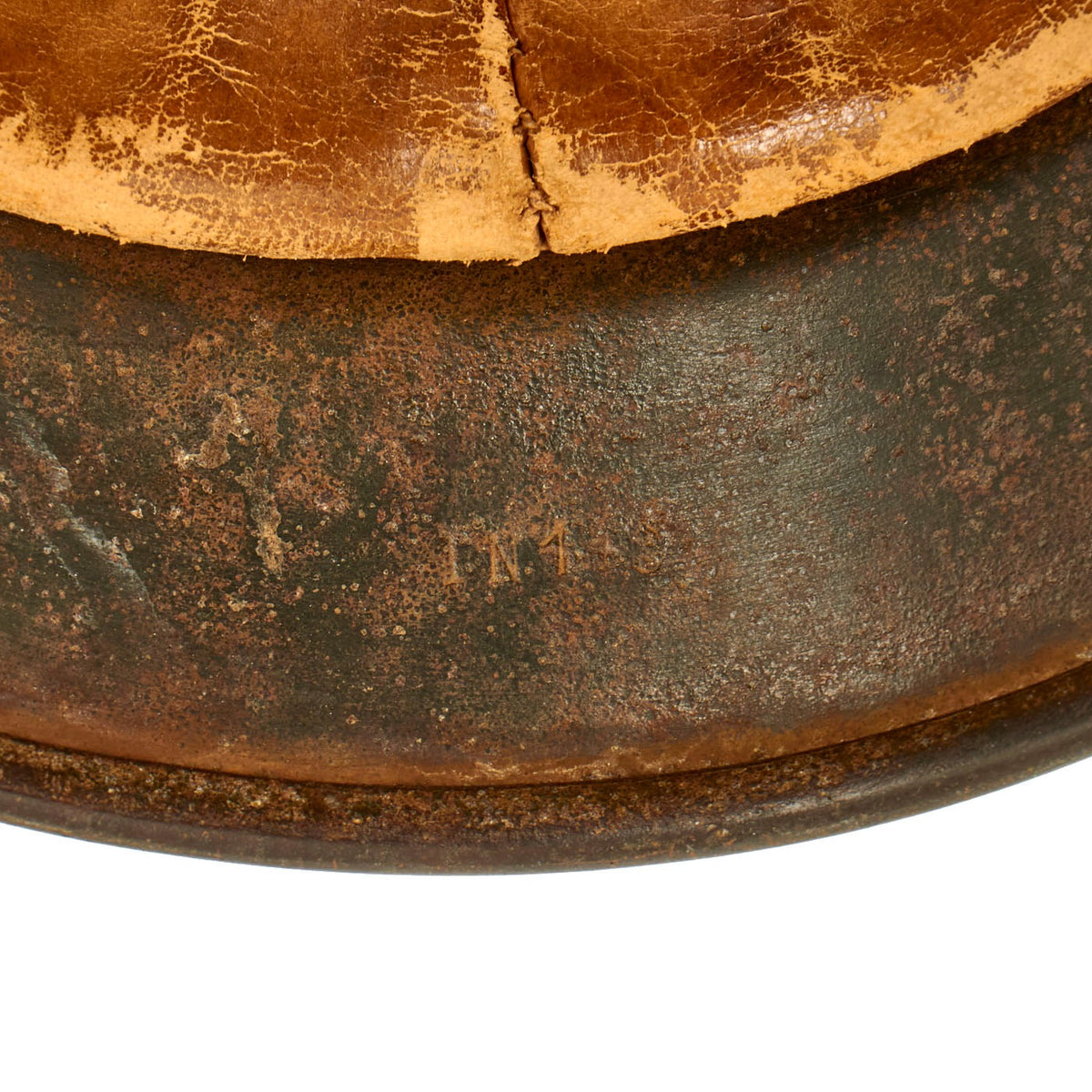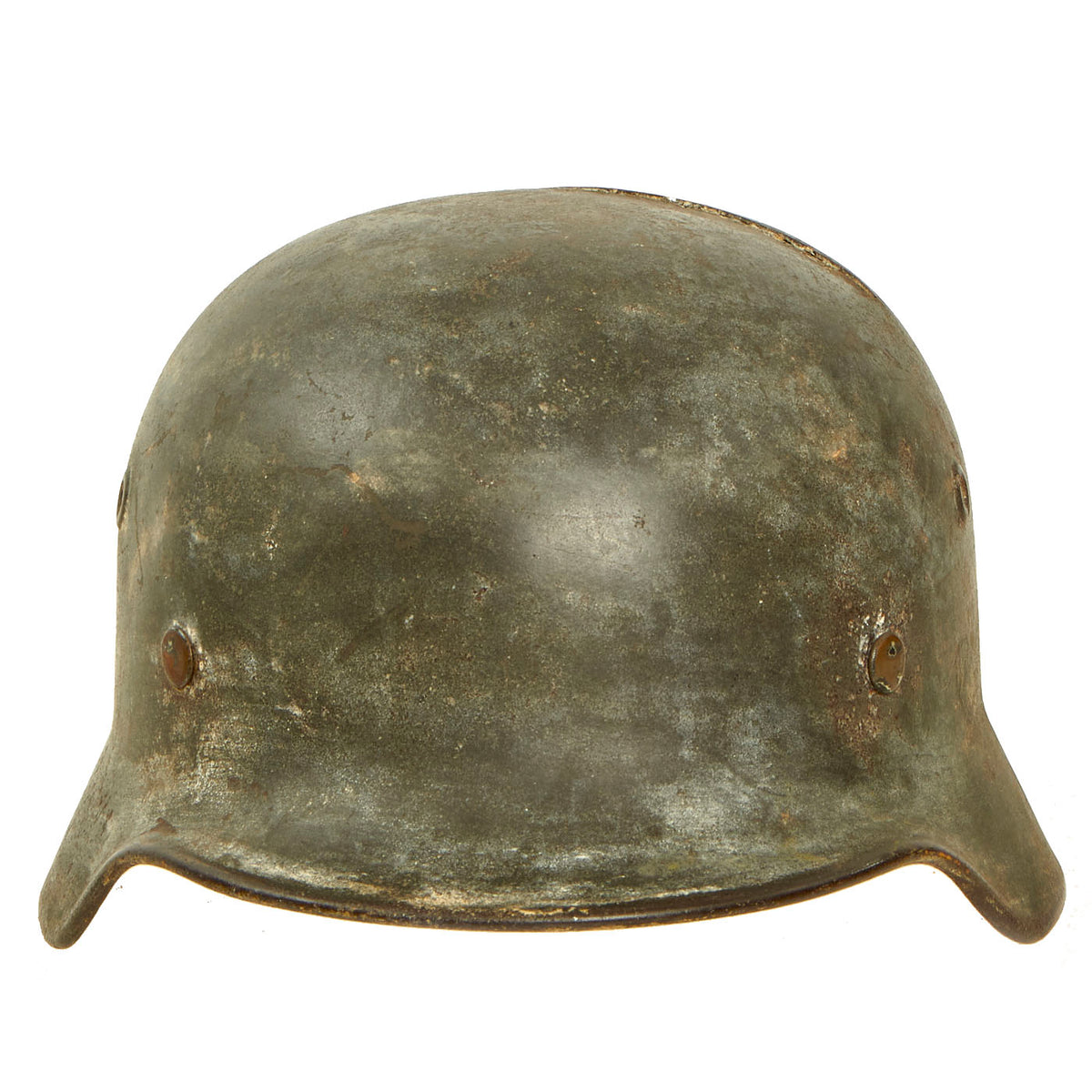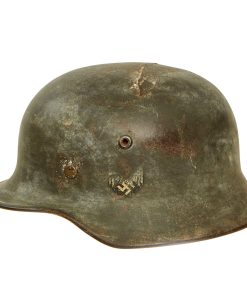Original German WWII Army Heer M40 Battle Damaged Partial Single Decal Steel Helmet – Stamped Q64 Original Items
$ 595,00 $ 178,50
Original Item: Only One Available. This is a very nice all original “battle damaged” example of a German WWII M40 helmet, issued to the Heer (Army). This stamped sheet steel construction helmet shows a lot of period wear, and looks like it was repainted several times, possibly once with a winter white wash camouflage. It has a large crack going most of the way across the top of the helmet, with a another crack running towards the back for a bit. Amazingly it looks like the helmet may have seen further service after the crack occurred, possibly during the very end of WWII when every possible resource was used. The left side of the helmet features a partial Heer eagle decal, which is retained about 30%, with damage from wear and use. Loads of history and a lovely patina on this helmet!
The reverse, interior, neck guard apron is serial number stamped IN140 and the interior, left side, apron has the stamped manufacturer’s code and size, Q64 indicating that it was manufactured by Quist in the German city of Esslingen. Size 64 is a nice smaller size that can accommodate liners from 56cm to 57cm or US 7 to 7 1/8. Size 64 shells are harder to find and are therefore more valuable to a collector.
All three original liner retaining pins are intact, however they have had most of their original paint worn away. The interior of the helmet still has part of an original leather liner, which is in very nice lightly worn condition, with an intact top tie and size 59 still stamped on the leather. The outer side of the mid war galvanized steel liner band over the left ear is marked 66 n.A / 59, indicating that this is a size 59 liner for a size 66 shell. It however has been modified by cutting out the front of the liner band, which is how it is able to fit into a size 64 shell. The cut marks are well oxidized, so this is definitely a WWII field modification from before it was damaged. The right side displays the full manufacture information, as well as a date:
SCHUBERTH-WERKE K.-G.
D. R. P.
1943
BRAUNSCHWEIG
There is unfortunately no chin strap present.
Overall a very interesting 100% genuine battle damaged M40 Single Decal Heer Army helmet, with a great service worn look! M40 helmets of this quality are always the hard to find on the market. This is an item that will only continue to appreciate in value over time.
The first “modern” steel helmets were introduced by the French army in early 1915 and were shortly followed by the British army later that year. With plans on the drawing board, experimental helmets in the field, (“Gaede” helmet), and some captured French and British helmets the German army began tests for their own steel helmet at the Kummersdorf Proving Grounds in November, and in the field in December 1915. An acceptable pattern was developed and approved and production began at Eisen-und Hüttenwerke, AG Thale/Harz, (Iron and Foundry Works), in the spring of 1916.
These first modern M16 helmets evolved into the M18 helmets by the end of WWI. The M16 and M18 helmets remained in usage through-out the Weimar Reichswehr, (National Defence Force, Circa 1919-1933), era and on into the early years of the Third Reich until the development of the smaller, lighter M35 style helmet in June 1935.
In 1934 tests began on an improved Stahlhelm, whose design was a development of World War I models. The Eisenhüttenwerke company of Thale carried out prototype design and testing, with Dr. Friedrich Schwerd once again taking a hand.
The new helmet was pressed from sheets of molybdenum steel in several stages. The size of the flared visor and skirt was reduced, and the large projecting lugs for the obsolete armor shield were eliminated. The ventilator holes were retained, but were set in smaller hollow rivets mounted to the helmet’s shell. The edges of the shell were rolled over, creating a smooth edge along the helmet. Finally, a completely new leather suspension, or liner, was incorporated that greatly improved the helmet’s safety, adjustability, and comfort for each wearer. These improvements made the new M1935 helmet lighter, more compact, and more comfortable to wear than the previous designs.
The Army’s Supreme Command officially accepted the new helmet on June 25, 1935 and it was intended to replace all other helmets in service.
More than 1 million M1935 helmets were manufactured in the first two years after its introduction, and millions more were produced until 1940 when the basic design and production methods were changed, replacing the multi-piece riveted vent with one stamped directly into the steel. Later, in 1942 the rolled steel rim was removed from the pattern to further expedite production.
Fast Shipping with Professional Packaging
Thanks to our longstanding association with UPS FedEx DHL, and other major international carriers, we are able to provide a range of shipping options. Our warehouse staff is expertly trained and will wrap your products according to our exact and precise specifications. Prior to shipping, your goods will be thoroughly examined and securely secured. We ship to thousands clients each day across multiple countries. This shows how we're dedicated to be the largest retailer on the internet. Warehouses and distribution centres can be located throughout Europe as well as the USA.
Note: Orders with more than one item will be assigned a processing date depending on the item.
Before shipping before shipping, we'll conduct a thorough inspection of the items you have ordered. Today, the majority of orders will be delivered within 48 hours. The delivery time will be between 3-7 days.
Returns
The stock is dynamic and we cannot completely manage it because multiple stakeholders are involved, including our factory and warehouse. So the actual stock may alter at any time. It's possible that you may not receive your order once the order has been made.
Our policy is valid for a period of 30 days. If you don't receive the product within 30 days, we are not able to issue a refund or an exchange.
You can only return an item if it is unused and in the same state as the day you received it. You must have the item in its original packaging.
Related products
Uncategorized
Uncategorized
Uncategorized
Uncategorized
Uncategorized
Uncategorized
Uncategorized
Band of Brothers ORIGINAL GERMAN WWII Le. F.H. 18 10.5cm ARTILLERY PIECE Original Items
Uncategorized
Uncategorized
Uncategorized
Uncategorized
Uncategorized
Australian WWII Owen MK1 Machine Carbine SMG Custom Fabricated Replica with Sling Original Items
Uncategorized
Uncategorized
Uncategorized
Armored Burgonet Helmet & Polearm from Scottish Castle Leith Hall Circa 1700 Original Items
Uncategorized
Uncategorized
Angolan Rebel 1970s era 60mm Inert Display Mortar from Angolan Civil War Original Items
Uncategorized
Uncategorized
